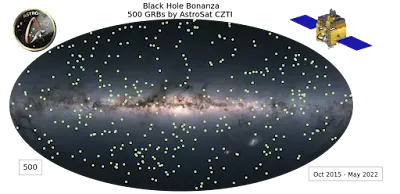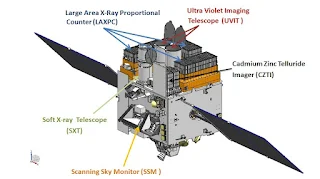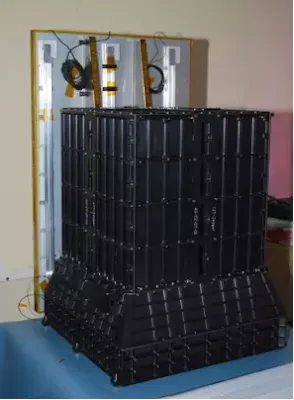ISRO's AstroSat mission observes 500th black hole birth with its X-ray instrument
India's Astrosat witnesses black hole birth for 500th time in space, records 'mini big bangs
 |
| Stylised image of Astrosat in front of a GRB. (Image credit: Astrosat - ISRO, GRB - ESA/Hubble/M Kornmesser CC-BY 4.0) |
Black holes are mysterious, massive and dense objects from which even light cannot escape, with new astronomical instruments beginning to unravel their mysteries. Black holes are the subject of intense scrutiny by astronomers around the world, with Indian scientists contributing to the understanding of these strange objects by contributing to the understanding of how black holes are formed, using observations by ISRO's AstroSat. One of the ways black holes are born are through the cataclysmic deaths of massive stars, which result in gamma ray bursts (GRBs), explosions so powerful that they are termed by the scientific community as 'mini Big Bangs.' AstroSat has observed 500 of these GRBs so far.
 |
| AstroSat (Image credit: ISRO) |
The GRBs dispatch intense rays of light and high energy particles at relativistic speeds across the universe. GRBs also result from the collisions of two neutron stars, the kind of event that produces gravitational waves, which can potentially be detected by the LIGO-India project in the future. Astronomers investigate the gamma rays and the X-rays from GRBs to better understand the formation of black holes. AstroSat is capable of simultaneously studying the universe in multiple wavelengths. There are five instruments on board, three of which can conduct X-ray observations, while the other two can see the universe in ultraviolet and visible light. One of the X-ray instruments, known as the Cadmium - Zinc - Telluride Imager (CZTI) was used to observe the RGBs.
 |
| The CZTI instrument on board AstroSat. (Image credit: ISRO) |
Principle investigator of CZTI, Dipankar Bhattacharya says, "This is a landmark achievement. The wealth of data obtained by CZTI on Gamma Ray Bursts is making a big impact worldwide." CZTI has been studying GRBs since it first began observations 6.5 years ago, in 2015. Lead of the GRB effort, Varun Bhalerao says, "The very first scientific result from AstroSat was the detection of GRB 151006A: just hours after the instrument was powered on after launch." Since then, the team has detected 500 GRBs, by refining and improving their search and detection methods every year, and getting progressively better results. PhD students and trainees play a major role in the detection efforts. PhD student Gaurav Waratkar says, "is very exciting to work on this. Every time we look at the data, I am tantalised by the possibility of discovering a signal that originated billions of light years away!"
One of the unique capabilities of the CZTI instrument is being able to measure the polarisation of X-rays, something that flagship missions by major international space agencies, such as the Fermi Space Telescope and the Neil Gehrels Swift Telescope lack. Astrophysicist Tanmoy Chattopadhyay says, "Polarisation tells us what is happening just outside the newly formed black hole. It is the most important measurement to distinguish between different theories of Gamma-ray Bursts."


Comments